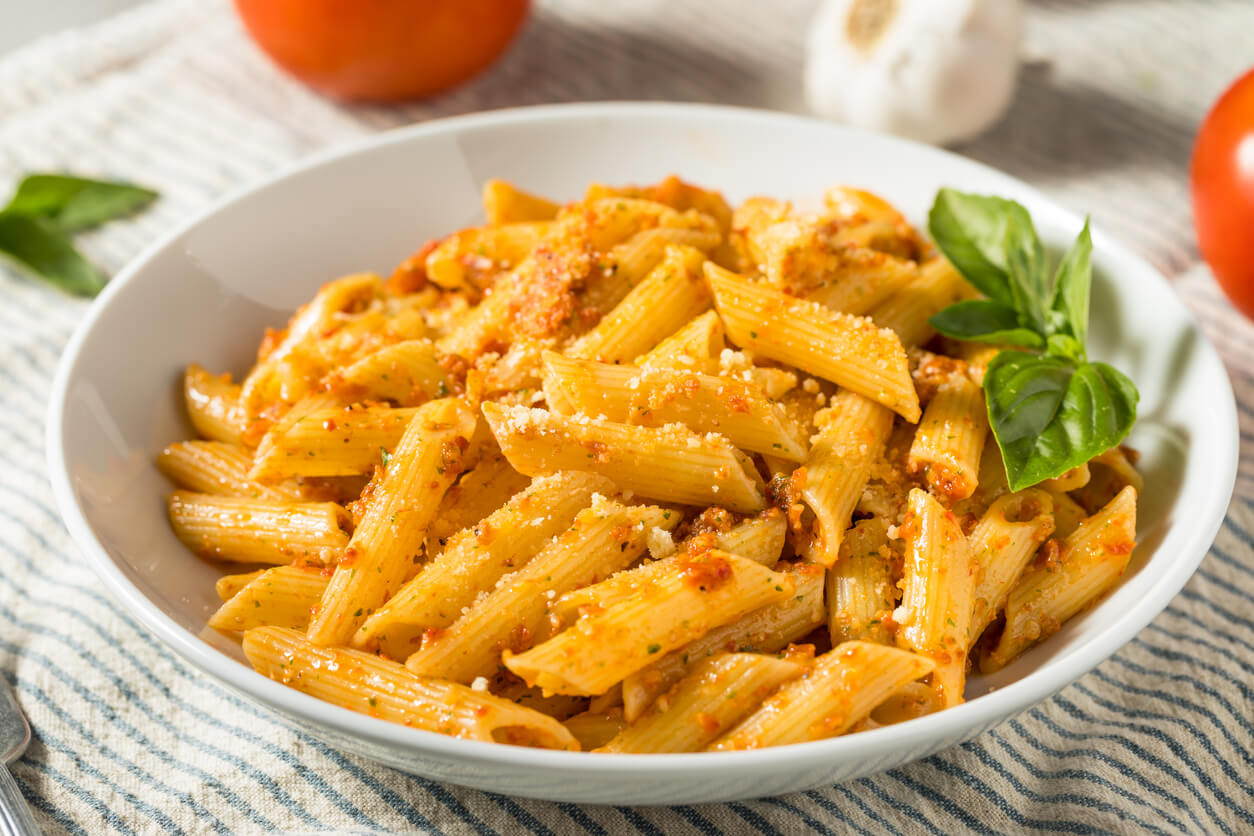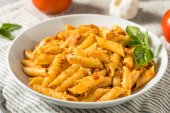
Paprika Pesto Pasta
This Paprika Pesto Pasta combines two culinary treasures with deep-rooted histories that have graced countless dishes with their vibrant flavors and rich heritage. Paprika, with its deep red hue and subtle sweetness, traces its roots back to Central America, where indigenous peoples cultivated chili peppers for thousands of years. It wasn’t until the 16th century that Spanish explorers introduced these peppers to Europe, where they were embraced and cultivated across the continent. Hungary, in particular, became renowned for its cultivation of paprika peppers, leading to the development of the rich and flavorful spice that we know today.
Pesto, a fragrant blend of basil, garlic, pine nuts, Parmesan cheese, and olive oil, hails from the Liguria region of northern Italy. The word “pesto” itself derives from the Italian “pestare,” meaning to pound or crush, a nod to the traditional method of preparing the sauce using a mortar and pestle.
In this contemporary twist on traditional pasta dishes, we combine the smoky warmth of paprika with the herbaceous notes of pesto to create a harmonious fusion of flavors. The recipe begins with roasted red peppers, smoked paprika, garlic, pine nuts, fresh parsley, lemon zest, and lemon juice—all carefully blended into a luscious pesto sauce. Gradually adding olive oil until the mixture achieves a smooth and velvety consistency ensures that every bite is infused with layers of flavor.
In the culinary world, tradition and innovation often intertwine, creating new and exciting possibilities for flavor exploration. With Paprika Pesto Pasta, we pay homage to the historic origins of paprika and pesto while embracing the creativity and versatility of modern cooking. Enjoy!
Print
Paprika Pesto Pasta
This vibrant and flavorful Paprika Pesto Pasta is a delightful twist on traditional pesto pasta, offering a rich and nutty flavor profile with a hint of smokiness. Enjoy it as a satisfying main dish or serve it as a side alongside your favorite protein.
- Prep Time: 15 minutes
- Cook Time: 15 minutes
- Total Time: 30 minutes
- Yield: 4 servings 1x
- Category: Entrées
Ingredients
- 2 red peppers (about 1 cup), chargrilled and peeled
- 1 1/2 tsp smoked paprika
- 2 fat cloves of garlic, peeled
- 2/3 pine nuts
- 4 tbsp chopped fresh parsley
- Zest and juice of one small lemon
- 1/3 cup + 1 tbsp olive oil
- 2/3 cup grated Parmesan cheese
- Salt and pepper
- Pasta
Instructions
- In a food processor, combine the roasted red peppers, smoked paprika, garlic cloves, pine nuts, chopped parsley, lemon zest, and lemon juice. Pulse until the ingredients are finely chopped and well combined.
- With the food processor running, gradually pour in half of the olive oil. Continue blending until the mixture forms a smooth, loose paste with a nutty texture. Add more olive oil as needed until you reach your desired consistency.
- Add the grated Parmesan cheese to the pesto mixture and pulse until fully incorporated. Taste and adjust seasoning with salt and pepper as desired.
- Cook your pasta according to package instructions until al dente. Drain and reserve a small amount of pasta water.
- In a large mixing bowl, toss the cooked pasta with the prepared pesto until evenly coated. If needed, add a splash of reserved pasta water to loosen the sauce and help it adhere to the pasta.
- Garnish with additional chopped parsley and a sprinkle of grated Parmesan cheese, if desired.
The Best Pasta for Your Paprika Pesto
Choosing the right pasta shape can make or break your dish, and with this smoky paprika pesto, you’ve got some fantastic options. Long, thin pastas like linguine or spaghetti are classic choices that allow the pesto to coat every strand beautifully. The sauce clings to these shapes, ensuring each bite delivers that perfect balance of smokiness and herbs.
If you’re feeling a bit more adventurous, try penne or rigatoni. These tube-shaped pastas are little flavor pockets that trap the pesto inside, giving you bursts of that gorgeous paprika goodness with every forkful. Plus, they’re sturdy enough to hold up to heartier additions like grilled chicken or roasted vegetables.
For those nights when you want something a little different, fusilli or rotini work wonderfully too. Their spiral shape grabs onto the pesto like nobody’s business, and they’re perfect if you’re planning to serve this as a pasta salad the next day (yes, it’s that good cold!).
Wine and Beverage Pairings
Let’s talk about what to drink with this beauty. The smoky paprika and rich Parmesan call for something that can stand up to those bold flavors without overwhelming the herbaceous notes. A crisp Sauvignon Blanc is my go-to choice – its acidity cuts through the richness while complementing the fresh parsley and lemon zest.
If you’re more of a red wine person, don’t worry! A light Chianti or Sangiovese pairs beautifully with the roasted red peppers and won’t compete with the delicate smokiness. The key is to avoid anything too heavy or oaky that might mask those lovely paprika notes.
For the non-wine drinkers in the crowd, try a sparkling water with a twist of lemon or even a light beer. The bubbles help cleanse your palate between bites, letting you fully appreciate each layer of flavor in this complex sauce.
Roasting Red Peppers at Home
While you can absolutely buy jarred roasted red peppers (and trust me, we’ve all been there on busy weeknights), roasting your own peppers takes this dish from good to absolutely incredible. The process is surprisingly simple and fills your kitchen with the most amazing aroma.
Start by placing whole red peppers directly over an open flame on your gas stove, turning them with tongs until the skin is charred and blistered all over. If you don’t have a gas stove, no worries – pop them under the broiler, turning every few minutes until they’re nicely blackened. Once they’re charred, immediately place them in a bowl and cover tightly with plastic wrap. This steaming process makes the skins slip off like magic after about 15 minutes.
The flavor difference between store-bought and home-roasted peppers is like night and day. Home-roasted peppers have this incredible smoky sweetness that perfectly complements the paprika, creating layers of flavor that’ll have your dinner guests asking for your secret.
Creative Variations
Once you’ve mastered the basic recipe, it’s time to have some fun! One of my favorite variations is adding sun-dried tomatoes to the food processor along with the other ingredients. They bring this intense, concentrated flavor that plays beautifully with the smokiness of the paprika.
For those who like a little heat, try adding a pinch of red pepper flakes or even a small piece of chipotle pepper in adobo sauce. The chipotle adds another dimension of smokiness that’ll make this dish absolutely addictive.
If you’re feeling fancy, substitute the pine nuts with toasted walnuts or almonds. Each nut brings its own personality to the dish – walnuts add earthiness, while almonds contribute a subtle sweetness that’s divine with the roasted peppers.
You can also play with different cheeses. While Parmesan is classic, try mixing in some aged Manchego for a Spanish twist, or use Pecorino Romano for a sharper, more intense flavor that really makes the paprika pop.
Making It a Complete Meal
While this pasta is absolutely delicious on its own, sometimes you want to turn it into a more substantial meal. Grilled chicken is the obvious choice, and for good reason – the char from the grill echoes the smokiness in the pesto beautifully. Just season some chicken breasts with salt, pepper, and a touch of paprika before grilling.
For seafood lovers, pan-seared shrimp or scallops are incredible with this sauce. The sweetness of the shellfish balances the earthiness of the paprika perfectly. Just be sure not to overcook them – nobody wants rubbery seafood!
Vegetarians aren’t left out either. Roasted vegetables like zucchini, eggplant, or cherry tomatoes make fantastic additions. The key is to roast them until they’re slightly caramelized, which adds another layer of sweetness to complement the smoky pesto.
If you’re lucky enough to have a garden, this recipe is a fantastic way to use up an abundance of red peppers. There’s something incredibly satisfying about creating a meal entirely from ingredients you’ve grown yourself – from the peppers and herbs to even the garlic.
Even if you don’t have a full garden, you can easily grow parsley in a small pot on a sunny windowsill. Fresh herbs make such a difference in pesto, and there’s nothing quite like snipping your own parsley just before cooking.
Growing your own ingredients also means you can experiment with different varieties. Try using different colored peppers – yellow or orange bells will create a different flavor profile while maintaining that sweet, smoky character.
Learn how to make your own paprika in How to Make Your Own Paprika From Your Garden. You’ll also discover the perfect peppers for making your own paprika in our Bell Peppers Gardening Guide. No matter whether you have a sprawling back 40 garden plot, a raised bed or two, or you’re squeezing some containers on a balcony, there’s a bell pepper variety ready for you to plant and grow. And you know that once you have bell peppers fresh from your own garden, there’s no going back to store-bought!
If you try this recipe, let me know what you think!


 Previous
Previous

